Nissei DSK-1011 User manual

INSTRUCTIONS
This manual is intended to assist you in the safe and efficient operation of BLOOD PRESSURE MONITOR DSK-1011. The product must be used in accordance with the procedures contained in this
manual and must not be used for purposes other than those described herein. It is important to read and understand the entire manual. In particular, please read carefully and become familiar with the
section entitled “TIPS ON TAKING YOUR BLOOD PRESSURE”.
BEDIENUNGSANLEITUNG
Dieses Handbuch soll den Anwender bei der sicheren und wirkungsvollen Blutdruckmonitors DSK-1011 unterstützen. Das Produkt ist in Übereinstimmung mit den in diesem Handbuch enthaltenen
Verfahren zu verwenden und darf nicht für irgendwelche, in diesem Handbuch nicht beschriebenen Zwecke verwendet werden. Lesen Sie bitte vor allem das Kapitel “TIPPS ZUR
BLUTDRUCKMESSUNG” aufmerksam durch und machen Sie sich damit vertraut.
INSTRUCTIONS
Ce guide est destiné à favoriser l'utilisation sûre et efficace de Moniteur de tension artérielle DSK-1011. Le produit doit être utilisé conformément aux procédures contenues dans le présent guide et ne
doit pas être utilisé à d'autres fins que celles décrites ici. Il est important de lire et de comprendre le guide dans sa totalité. En particulier, veuillez lire attentivement et vous familiariser avec la section
intitulée “CONSEILS POUR MESURER VOTRE TENSION ARTÉRIELLE”.
ISTRUZIONI
Questo manuale assiste l'utilizzatore nell'uso efficiente e sicuro dello Sfigmomanometro DSK-1011. Usare il prodotto seguendo le procedure specificate nel presente manuale. Il prodotto non deve
essere usato per scopi diversi da quelli indicati. Si raccomanda di leggere attentamente tutto il manuale. In particolare, si raccomanda di leggere e seguire attentamente le informazioni riportate nella
sezione “CONSIGLI SULLA MISURAZIONE DELLA PRESSIONE SANGUIGNA”.
ΟΔΗΓΙΕΣ
Το εγχειρίδιο αυτό προορίζεται για να βοηθήσει το χρήστη στην ασφαλή και αποτελεσματική λειτουργία του Ψηφιακού Μετρητή Αρτηριακής Πίεσης DSK-1011. Το προϊόν πρέπει να χρησιμοποιείται
σύμφωνα με τις διαδικασίες που περιλαμβάνονται στο παρόν εγχειρίδιο και δεν πρέπει να χρησιμοποιείται για σκοπούς διαφορετικούς από εκείνους που περιγράφονται στο παρόν. Είναι σημαντικό
να διαβάσετε και να κατανοήσετε το εγχειρίδιο εξ ολοκλήρου. Ειδικότερα, διαβάστε προσεκτικά και εξοικειωθείτε με την ενότητα “ΣΥΜΒΟΥΛΕΣ ΓΙΑ ΤΗ ΜΕΤΡΗΣΗ ΤΗΣ ΑΡΤΗΡΙΑΚΗΣ ΣΑΣ ΠΙΕΣΗΣ”.
INSTRUKCJA OBSŁUGI
Niniejsza instrukcja użytkowania ma na celu pomóc użytkownikowi w bezpiecznym i sprawnym korzystaniu z elektronicznego ciśnieniomierza krwi DSK-1011. Aparat winien być używany zgodnie z
zaleceniami niniejszej instrukcji i nie może być wykorzystywany do innych celów niż wymienione poniżej. Istotne jest, aby użytkownik przeczytał dokładnie i zrozumiał niniejszą instrukcję. W
szczególności prosimy o uważne zapoznanie się z działem zatytułowanym “UWAGI DOTYCZĄCE POMIARÓW CIŚNIENIA”.
BLOOD PRESSURE MONITOR
GB
DE
FR
IT
GR
PL

-2-
CONTENTS
PART NAMES AND PRODUCT COMPONENTS.............2
GENERAL INFORMATION ................................2
PRECAUTIONS AND CONTRAINDICATIONS ..............5
TIPS ON TAKING YOUR BLOOD PRESSURE ..............6
PREPARATION BEFORE USE.............................7
MAKING A MEASUREMENT ..............................8
VIEWING THE SAVED READINGS (MEMORY FUNCTION).11
TROUBLESHOOTING....................................12
TECHNICAL DESCRIPTION FOR ELECTROMAGNETIC
DISTURBANCES ........................................13
PART NAMES AND PRODUCT COMPONENTS
MAIN UNIT
CUFF
AA (LR6) BATTERIES
INSTRUCTIONS
BATTERY COMPARTMENT
AIR CONNECTOR
AC CONNECTOR
“SET” KEY MEMORY KEY [1]
MEMORY KEY [2]
“START/STOP” KEY For test use
AIR PLUG
AIR HOSE
DISPLAY
AC adaptor not included
GENERAL INFORMATION
INDICATIONS FOR USE
This product is intended for noninvasive measurement of systolic and diastolic blood
pressure, determination of pulse rate and calculation of pulse pressure in adults in a home
healthcare environment. The product is not designed for neonatal use. Please consult with
your doctor or physician to use this product to take blood pressure of child or person in
pregnancy or under pre-eclamptic condition.
METHOD OF MEASUREMENT
This product employs the oscillometric method for measurement of blood pressure and
pulse rate. The cuff is connected to the main unit and wrapped around the arm. Circuits
within the cuff sense the small oscillations in pressure against the cuff produced by the
expansion and contraction of the arteries in the arm in response to each heart beat. The
amplitude of each pressure waves is measured, converted to millimeters of mercury, and

-3-
displayed on the LCD as a digital value.
MEASUREMENT ON INFLATION
Initially the cuff is rapidly inated to the prescribed value at
the beginning of a measurement, during which the ination
mark is displayed. After the pressure reaches this point,
the ination mark disappears and the cuff is inated more
gradually, during which pulse wave is detected. As pulse
wave is detected, heart mark ashes with synchronizing
beep. Measurement ends when systolic blood pressure is
determined and air is exhausted from the cuff.
PERSONAL MODE
The ination is adjusted based on the latest three readings
in the selected bank, either [1] or [2], to shorten the
measurement time and to improve comfort.
For example, high diastolic blood pressure values from
past three measurements will lead to ination to higher
pressure value than the default value. In the event that this
value is too high for your current blood pressure, the cuff
will rapidly deate and measurement will restart.
To use the personal mode effectively, chose the memory bank before starting a measurement.
This monitor remembers the last memory bank that was displayed. To choose the memory
bank before starting a measurement, display a reading saved in the desired memory bank,
turn off the monitor once and then start measurement.
WHO CLASSIFICATION SYMBOL
easured blood pressure values are classied against WH guideline 1999.
The higher class applies when systolic and diastolic pressures fall into different classes.
For specic information on your blood pressure, contact your physician. Never make any
judgment on your own based on the classication indication only.
PRESSURE
TIME
RAPID
INFLATION
RAPID
EXHAUST
GRADUAL
INFLATION
PRESSURE
TIME
AN EXAMPLE OF PRESSURE
HANG DTIND WITH
“PERSONAL MODE”
INITIAL PRESSURE
CHANGE
SYS
>180
160-179
140-159
130-139
120-129
<120
DIA
>110
100-109
90-99
85-89
80-84
<80
WHO CLASSIFICATION
Hypertension (severe)
Hypertension (moderate)
Hypertension (mild)
High Normal
Normal
Optimal
DISPLAY
PULSE PRESSURE DISPLAY
This product calculates and displays pulse pressure.
While systolic blood pressure keeps increasing with age, diastolic blood pressure tends
to start decreasing at around age 50. Pulse pressure is value subtracting diastolic value
from systolic value and therefore pulse pressure tends to increase with age. Pulse pressure
has been considered to be related to stiffness of artery and has been studied as one of
circulatory risk factors. It is sometimes said that 45 mmHg of pulse pressure is normal value.
Pulse pressure only does not represent arterial sclerosis. However, observation of pulse
pressure in long term will be important.
BODY MOTION SYMBOL
Blood pressure value taken while moving cannot be said to be the correct value because
body movement can affect blood pressure.
This product analyzes pulse wave and displays ] when body motion is detected.
[ ] indicates the results might be affected by body movement.

-4-
IRREGULAR PULSE RHYTHM SYMBOL
Pulse rhythm can be disturbed from talking,
moving or arrhythmias. This product displays
[] when the difference of shortest and
longest time intervals between pulse waves is
over 25%, indicating irregular pulse rhythm.
MEMORY FUNCTION
The measured values are automatically saved for later review in either one of two memory
banks, [1] or [2]. These two memory banks can be used to save readings of two persons
separately or to save morning readings and evening readings separately.
ach bank can save up to 60 readings. When the number of stored readings reaches 60, the
oldest reading will be deleted to record new reading.
Saved readings are recalled with measurement date and time when clock function is
activated. *The clock needs to be activated before measurement for date and time to be
saved with the measured valued.
[Err] results are not saved.
CARE AND MAINTENANCE
Keep the product clean. Inspect its cleanliness after use. To clean, use only a soft dry cloth.
Do not use gasoline, paint thinner, or other strong solvents. Since the cuff may absorb
perspiration and other uids, inspect it for stain and discoloration after each use. When
cleaning the cuff, use a synthetic detergent and gently rub the surface. Air dry thoroughly.
ake sure uid never gets in AI HS. Do not machine wash or scrub it.
When storing the product, do not place heavy objects on it. Do not fold or bend the cuff
forcibly. To disconnect the cuff from the main unit, do not pull AIR PLUG but hold AIR
PLUG and unplug it. Do not coil AIR HOSE too tightly. In case the product is stored in the
environment with ambient temperature above 0 or below 10, please leave it for at least
2 hours before taking a measurement. Remove the batteries if the product is to be stored for
an extended period of time. Keep the batteries out of reach of children.
Stop using the product immediately and contact your dealer or the manufacturer in case any
regular pulse rhythm
An example of irregular pulse rhythm
compared to regular pulse rhythm
visible damage is found on the device.
We suggest that you have your blood pressure monitor checked every 2 years. This operation
may only be performed by the manufacturer or by rms authorized by the manufacturer.
PRODUCT SPECIFICATIONS
Model : DSK-1011
Operating principle : Oscillometric method
Indicator : 15 digits liquid crystal display
Pressure indicating range : 0 to 300 mmHg cuff pressure
Measuring range : 50 to 250 mmHg systolic, 0 to 180 mmHg diastolic,
0 to 160 bpm pulse rate
Accuracy* : 3 mmHg cuff pressure, 5 of reading pulse rate
Ination :Automatic ination
Exhaust : Automatic exhaust valve
Power supply : Four 1.5 volt 6 AA alkaline batteries or A adaptor
AD-W5 series
Electric rating : D6V/W, with four 6 batteries
Adaptor A100-20V, 50-60Hz, 0.12A,
Unit; DC6V, 500mA, with designated AC adaptor
Memory : 2 banks, each stores 60 readings
Operating condition : 10 to 0, 15 to 85 H noncondensing
Transportation/storage condition : -20 to 60, 10 to 95 H noncondensing
Cuff :
Coverage arm circumference; 22 to 32 cm, applied part; BF
Main unit : Weight Appro. 250 g without batteries
Size Appro. 115 115 65.9 mm W D H
Protection class IP : IP 20: Protected against solid foreign particles with a
diameter of more than 12.5 mm, no protection against
water.
Protection against electric shock : Internally powered equipment/Class II equipment, Type
BF applied part
Mode of operation : Continuous operation
lassication : Class II / Internally powered equipment

-5-
Expected service life : 5 years
Key to symbols : Type BF applied part
: Class II equipment
: Refer to instruction manual/booklet.
: Keep dry
:The used electrical and electronic products are not
household waste. Follow your national/local recycling
rules to dispose of them properly. In the EU countries,
please refer to waste management symbols marked on
the package or the instrument.
*Accuracy is guaranteed with the measured values that are within the measuring range.
This device complies with N1060-1:1995A2:2009 Non-invasive sphygmomanometers
art 1: General reuirements and N1060-3:1997A2:2009 Non-invasive
sphygmomanometers Part 3: Supplementary requirements for electro-mechanical blood
pressure measuring system.
The measurement accuracy of the product has been proven according to IS 81060-2
protocol. In the clinical study, K5 was used for the determination of diastolic pressure
values at all auscultatory measurements.
• This product is intended for use in the environment with one atmospheric pressure.
Specications are subject to change without notice due to improvements in performance.
PRECAUTIONS AND CONTRAINDICATIONS
Do not use this product without consultation with your doctor if you are under
dialysis therapy or on anticoagulants, antiplatelets or steroids. Use of this instrument
under such conditions could cause internal bleeding.
For specic information on your blood pressure, contact your physician. Never make
any judgment on your own regarding measurement results.
Do not use this product along with implantable and wearable medical electrical
equipment such as pacemaker, debrillator, or electrocardiographic monitor. This
product is not also intended to be used with HF surgical equipment.
Do not use this product in an explosive environment such as near ammable
anesthetics or inside oxygen chamber.
The system may fail to yield specied measurement accuracy if operated or stored
in temperature or humidity conditions outside the limits stated in the specications
section of this manual.
Do not use cuffs or accessories other than those specied by the manufacturer.
Otherwise, correct measurement readings cannot be obtained.
Use of this product in areas near mobile phones, microwave ovens or other devices
with strong electromagnetic eld may cause malfunctions.
Do not apply the cuff over wounded arm, arm under an intravascular access or
therapy or an arterio-venous shunt, or arm on the side of a mastectomy or lymph
node clearance. Otherwise injury may be resulted.
Make sure that ination of the cuff is not causing prolonged impairment of blood
circulation. Also, be cautious about temporary loss of the functions of any other
medical equipment if any monitoring equipment is used on the same limb with the
blood pressure measuring cuff.
To avoid harmful injury due to interfered blood ow from cuff ination,
- Make sure that AIR HOSE is not kinking before measurement. Otherwise, cuff
ination may not be conducted properly and prolonged, and
- Do not make measurements repeatedly.
To avoid any possibility of accidental strangulation, keep this product away from
children and do not drape AIR HOSE around your neck.
Because the product includes precision parts, avoid extreme temperature variations,
humidity, shock, dust, lint, and direct sunlight. Do not drop or strike the product.
Other manuals for DSK-1011
1
Table of contents
Languages:
Other Nissei Blood Pressure Monitor manuals

Nissei
Nissei WSK-1011 User manual
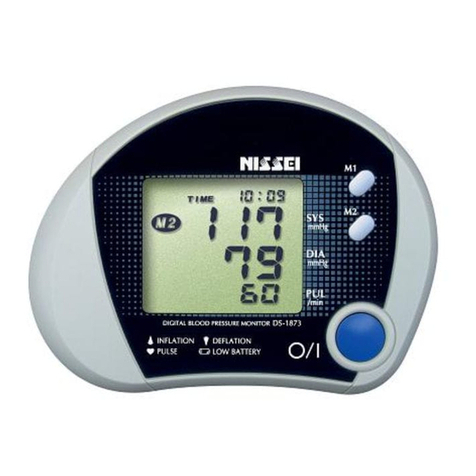
Nissei
Nissei DS-1873 User manual

Nissei
Nissei WS-820 User manual

Nissei
Nissei DSK-1031 User manual

Nissei
Nissei WS-1011 User manual
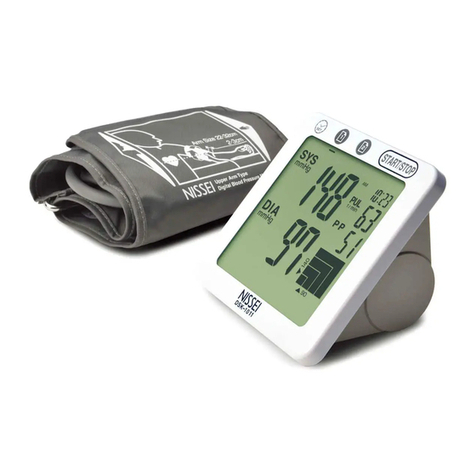
Nissei
Nissei DS-1011 User manual
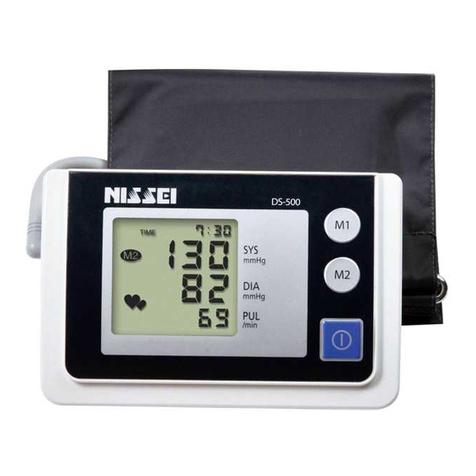
Nissei
Nissei DS-500 User manual
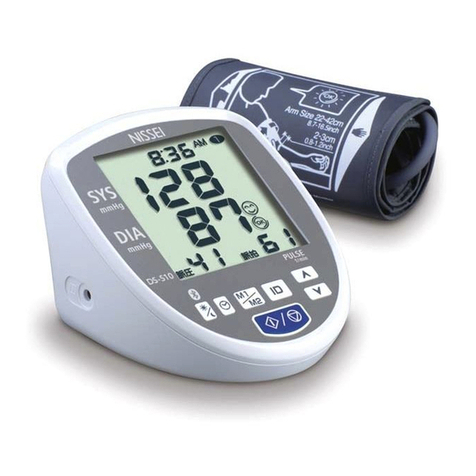
Nissei
Nissei DS-S10 User manual
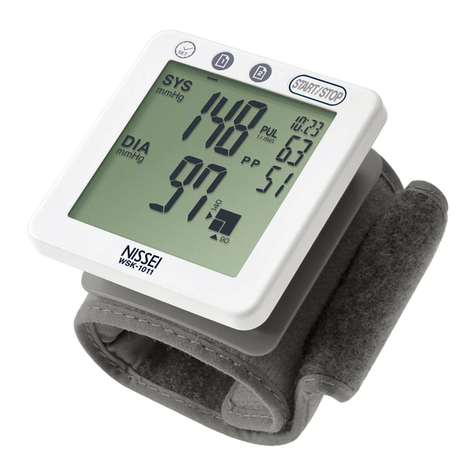
Nissei
Nissei WSK-1011 User manual
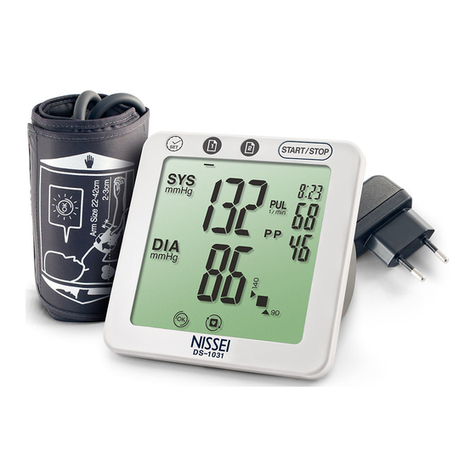
Nissei
Nissei DSK-1031 User manual
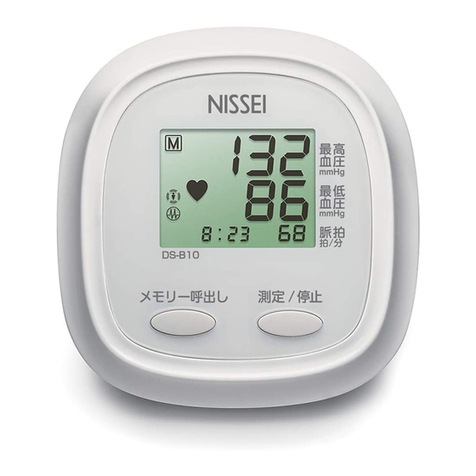
Nissei
Nissei DS-B10 User manual

Nissei
Nissei WSK-1011 User manual

Nissei
Nissei DSK-1031 User manual
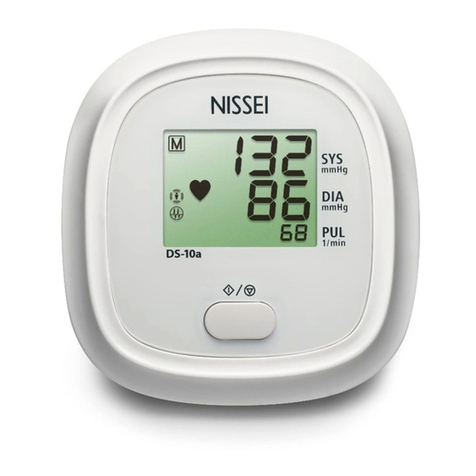
Nissei
Nissei DS-10a User manual

Nissei
Nissei WS-820 User manual

Nissei
Nissei DS-137 User manual
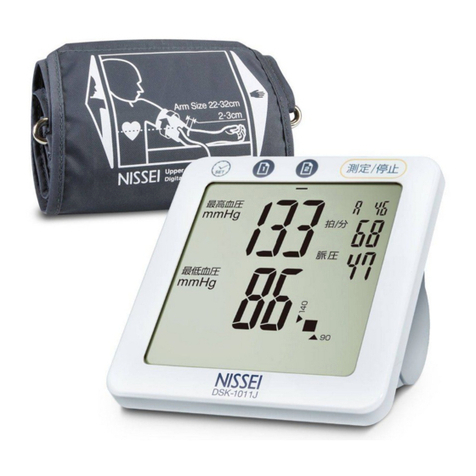
Nissei
Nissei DSK-1011J User manual
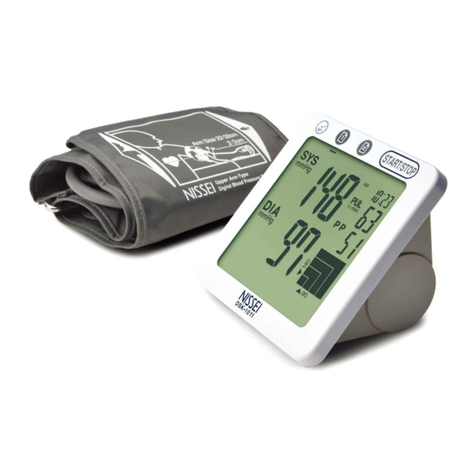
Nissei
Nissei DSK-1011 User manual
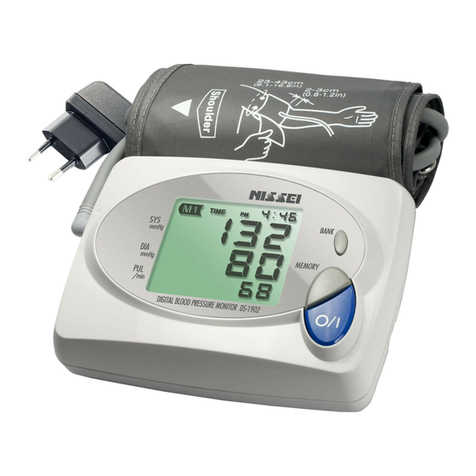
Nissei
Nissei ds-1902 User manual
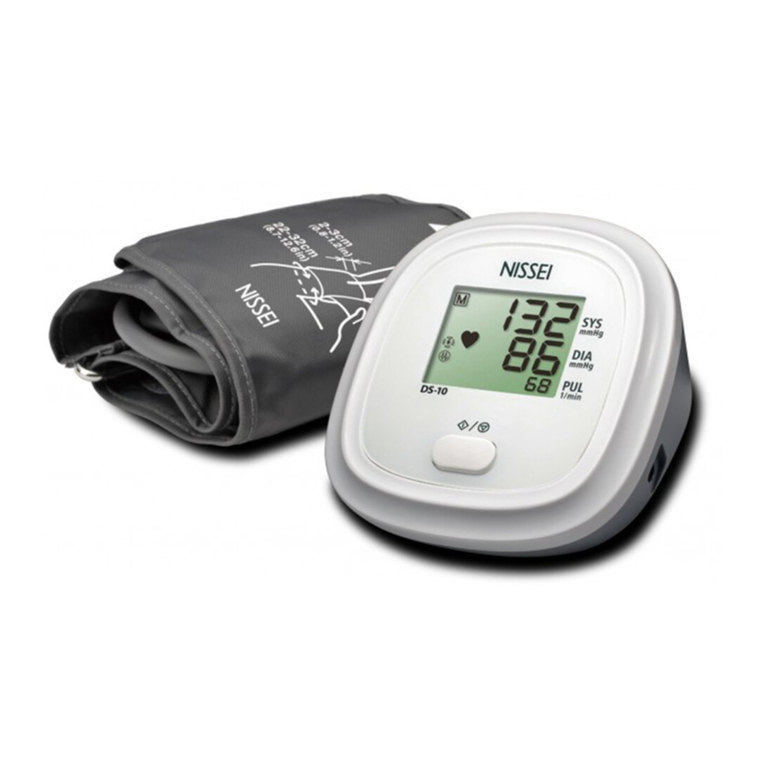
Nissei
Nissei DS-10 User manual





















